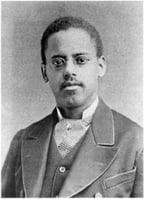.png?height=630&name=Franklin%20Social%20Graphics%20(5).png)
Black History Month is a time to elevate stories that have never been told before or that haven’t been told enough, and a reminder that we should share these stories all year. Below are three in a long list of Black contributions to America’s clean energy evolution. Their scientific brilliance alone is praiseworthy. Their tenacity, grit, and determination in succeeding despite systemic racism and discrimination should make them household names.
Lewis H. Latimer, 1848 – 1928
He turned the light bulb from an expensive luxury item to an efficient public necessity.
Lewis H. Latimer, born to parents who had fled North to escape slavery, became an inventor and gifted patent illustrator. His work paved the way for widespread public and in-home electric lighting. In fact, before Latimer came along, Thomas Edison’s light bulb only lasted a few days, making it a novelty for only the wealthy. While working for Edison’s main rival, Hiram Maxim, Latimer invented a carbon filament design that greatly extended its life and helped the bulb go mainstream. Latimer supervised the installation of the first electric plants in Philadelphia, New York City, and Montreal. He continued inventing devices that improved public life, such as a better train-car restroom and an early version of what would now be called an air conditioner. Read more about his many accomplishments from the Institute of Electrical and Electronics Engineers.
Annie Easley, 1933 – 2011
A “human computer,” her equations and coding powered rockets and alternative energy technology.
 If Annie Easley hadn’t read the newspaper one day, her life might have taken a very different path. She had recently moved to Cleveland in 1955 and was looking for a job. She saw an article in the local paper about two Black female “computers” at NASA and that the agency needed more people good at math. She applied and got the job, becoming one of only four Black employees at her research lab. Easley was literally a “human computer” who did machine-level computations by hand. When computers eventually did take over the calculations, however, she learned programming and coding. Her work was used to analyze wind and solar energy projects, as well as batteries for early hybrid vehicles. She was also on the team that developed Centaur technology at NASA, which uses liquid hydrogen and liquid oxygen to blast rockets into space. Learn more about her work at the Glenn Research Center of NASA.
If Annie Easley hadn’t read the newspaper one day, her life might have taken a very different path. She had recently moved to Cleveland in 1955 and was looking for a job. She saw an article in the local paper about two Black female “computers” at NASA and that the agency needed more people good at math. She applied and got the job, becoming one of only four Black employees at her research lab. Easley was literally a “human computer” who did machine-level computations by hand. When computers eventually did take over the calculations, however, she learned programming and coding. Her work was used to analyze wind and solar energy projects, as well as batteries for early hybrid vehicles. She was also on the team that developed Centaur technology at NASA, which uses liquid hydrogen and liquid oxygen to blast rockets into space. Learn more about her work at the Glenn Research Center of NASA.
Lonnie Johnson, 1949 – present
His invention could revolutionize how we store and use solar energy.
As a kid in Mobile, Ala., Lonnie Johnson loved taking apart household items and toys to see how they worked. So, it makes sense that he grew up to invent the Super Soaker, one of the most popular toys of all time. However, he stumbled upon this invention while trying to create an environmentally friendly heat pump. That task reflected his regular, more serious work as a nuclear engineer and researcher, with roles at the Strategic Air Command of the US Air Force and NASA’s Jet Propulsion Laboratory. After he left government service, he went on to form other companies and continued researching clean energy sources. One of his inventions, the Johnson Thermoelectric Energy Converter (JTEC) is an advanced heat engine that converts solar energy into electricity with twice the efficiency of existing methods. Read more about his work and other inventions at the National Inventors Hall of Fame.
Achieving a carbon-free energy future is an all-hands-on-deck situation. To get there, we need to invite to the table a range ideas and voices as diverse as the problems we’re trying to solve. Want to join our table at Franklin Energy? Check out our available job openings.

.png)
.png)


.png)
